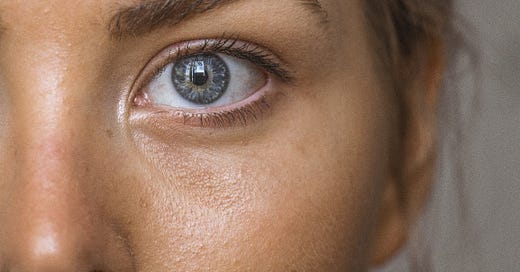Why Does Our Eyesight Deteriorate As We AGE?
Eye spy with my little eye a number of eye problems that can come up with age.
We tend to associate old age with failing eyesight. It’s not that easy to see as we get older, and that ain’t really helped with the aid of reading glasses or other gadgetry at hand.
There are so many eye-related issues that can plague us as we age, including (but not limited to) glaucoma, cataracts or age-related macular degeneration (AMD).
According to the US Centers for Disease Control and Prevention (US CDC),
AMD is the leading cause of permanent impairment of reading and fine or close-up vision among people aged 65 years and older.
According to the National Eye Institute (NEI),
Age-related macular degeneration (AMD) is an eye disease that can blur the sharp, central vision you need for activities like reading and driving. “Age-related” means that it often happens in older people. “Macular” means it affects a part of your eye called the macula.
AMD is a common condition — it’s a leading cause of vision loss for people age 50 and older. AMD doesn’t cause complete blindness, but losing your central vision can make it harder to see faces, drive, or do close-up work like cooking or fixing things around the house.
AMD happens very slowly in some people. Even if you have early AMD, you may not experience vision loss for a long time. For other people, AMD progresses faster and can lead to central vision loss in one eye or both eyes.
AMD, according to the definition from the NEI, is a degeneration of the macula. According to the VMR Institute,
The macula is the central area of the retina and is of particular interest to retina specialists. Remember, that the retina is the light sensitive tissue which lines the inside of the eye. The macula is the functional center of the retina. It gives us the ability to see “20/20” and provides the best color vision.
Therefore, any degeneration of the macula would result in a reduced sensitivity of our eyes to light stimulation, which would then “make it harder to see faces, drive, or do close-up work like cooking or fixing things around the house”.
The problem that arises from AMD is the accumulation of drusen on the retinae in our eyes, which are described as “small yellow deposits of fatty proteins (lipids) that accumulate under the retina”.
These drusen particles will end up blocking light waves from hitting our retinae, and therefore cause an impeded vision — we would not be able to see things as clearly as we ought to.
And we can draw a parallel between these aggregated drusen proteins with the amyloid beta protein aggregates that are a symptom of Alzheimer’s disease.
Misfolded Proteins In The Brain Could Be A Case For Alzheimer's.
There are so many different types of proteins in the body. In fact, it is estimated that the human body contains 80,000–400,000 different types of proteins, and these proteins are present for different purposes in the body.
It’s just yet another form of protein misfolding.
According to this article,
AMD is a vascular-metabolic-inflammatory disease, in which two sets of extracellular deposits, soft drusen/basal linear deposit (BLinD) and subretinal drusenoid deposit (SDD), confer risk for end-stages of atrophy and neovascularization.
This review focuses on soft drusen/BLinD, summarizing evidence that a major ultrastructural component is large apolipoprotein B,E-containing, cholesterol-rich lipoproteins secreted by the retinal pigment epithelium (RPE) that offload unneeded lipids of dietary and outer segment origin to create an atherosclerosis-like progression in the subRPE-basal lamina space.
Which does indicate that the fatty drusen deposits are linked to cholesterol issues.
Also, other studies have found that Advanced Glycation End-products (AGEs) are found in those drusen deposits:
Advanced glycation endproducts (AGE) accumulate with aging and are linked to several age-related diseases such as Alzheimer’s disease, osteoarthritis, atherosclerosis and AMD. AGE deposits are found in drusen and in Bruch’s membrane of the eye and several studies have suggested its role in promoting oxidative stress, apoptosis and lipofuscin accumulation.
Which, of course, is something that can be tied down to an overconsumption of sugar in our diets:
The Sugar Involved With Our Declining Health Is Great For Business.
Wherever we go today, we are bombarded by advertisements for various sugar-rich foods, much like how scantily dressed women are seen in many different advertisements today.
The moral of the story here, therefore, is that diabetes does provide a greater risk factor for the development of AMD (not that diabetics don’t have a chance of developing diabetic retinopathy first) - and improper cholesterol management may also be yet another risk factor.
But what we do understand is that diabetes and high blood cholesterol can be pro-inflammatory situations, which can therefore unleash a chain of dominos on other inflammation-dependent biological pathways.
It Isn't Really Just The Cholesterol That Contributes To Heart Disease.
The cholesterol molecule is something that we have a problem with.
Protecting our eyesight is key. We don’t want to end up going blind unnecessarily. Not when AMD is something that we can actually prevent in the first place. But a lot of people don’t even know how AMD comes about, and end up paying for it with a reduced quality eyesight in their later years.
Otherwise, the risk of having an impaired eyesight leading into blindness is real. Especially if we don’t take care of it properly in our younger years!
Eye spy with my little eye some Nutrients That Support Healthy Eye Functions somewhere, too!
Nutrients That Support Healthy Eye Functions
Why does our eyesight deteriorate as we age? The issue of age-related macular degeneration (AMD) is a problem that most people do face as they age.
Do feel free to share this article and hit the “subscribe” button to get more updates about the science concepts in nutrition and health, all deconstructed nicely for your convenient perusal!








